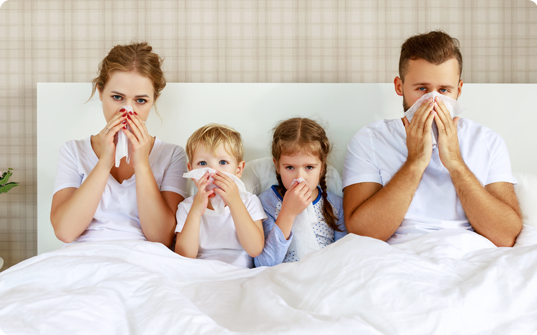
The hereditary nature of house dust mite allergy

Parents who already know that they are allergic to house dust mites can do quite a bit to help their children avoid uncomfortable and debilitating symptoms. After all, dust mite allergy – and allergies in general – is strongly hereditary. It’s important not to wait before symptoms begin to take action.
When it comes to allergies, the apple doesn’t fall far from the tree
Allergies are highly heritable, and plenty of studies conducted around the world have revealed useful insights into the genetics of dust mite allergy.
“As a practicing allergist, I often get questions from concerned parents who have already experienced the uncomfortable symptoms of dust mite allergy,” notes Dr Xavier Van der Brempt, pulmonologist and allergologist. “It’s well-established that if one parent has allergies, a child has a 30% chance of being allergic. If both parents are allergic, that chance rises to 50%. When both parents have the same allergy – to dust mites, for example – their child is 80% likely to suffer from it too.”

Avoid allergens, avoid allergies
It sounds logical, but if you successfully avoid contact with allergens like dust mites, you won’t experience allergy symptoms – even if you are genetically predisposed to developing an allergy.
“There has been some interesting recent research on this topic,” Dr Van der Brempt continues. “I contributed to a study of a population of children who spent their time between two cities in France – one at a higher altitude, and one at a lower altitude. Dust mites are uncommon at higher altitudes with lower humidity, and the data confirmed that when children moved from the lower to the higher-altitude city, their allergy symptoms disappeared.”
But avoiding allergies is easier said than done. Dr Van der Brempt: “It’s one thing if a child is allergic to cats; simply avoid having cats around. But in the case of ever-present pollen in the very air we breathe, things get complicated. It has also been proven that exposure to multiple triggering allergens adds up.”
Gain insights early to minimize risk
Parents have a responsibility. If they are already aware of their own allergies, they should take steps to safeguard their child’s health and well-being.
“New-borns can be allergic – but it’s rare,” continues Dr Van der Brempt. “The youngest patient I’ve tested for allergy was one month old, and the youngest child to test positive for house dust mite allergy in my experience was only seven months old.”
“When parents ask me when they can take measures to reduce or even prevent the development of allergies in their children, I tell them they don’t have to wait until they are seven or even three years old. The key here is to gain insights into allergic predispositions early and then to work to minimise the child’s exposure to allergens. In this way, it’s possible to completely avoid the development of distressing symptoms like allergic asthma.”
"The key is to gain insights into allergic predispositions early and then minimise the child’s exposure to allergens. In this way, it’s possible to completely avoid the development of distressing symptoms" Dr Xavier Van der Brempt
You can take action even before your child is born
With this in mind, it’s clear that avoiding exposure is a powerful way for parents to maximise their children’s quality of life – from day one.

Research has shown that continued exposure to dust mites increases the severity of dust mite allergy symptoms and may even lead to asthma, which can be a real handicap (in certain situations). It’s possible to safely and effectively eliminate dust mites – and their feces – from your child’s environment from the very beginning, preventing infestations in teddy bears and mattresses and helping to ensure the high-quality sleep essential for optimal growth and development.
Dr Van der Brempt: “Children suffer because of dust mite allergy just as much as adults. They can have difficulties in school, develop sleep disorders, perform poorly in sports, have lower self-esteem, and much more. It’s also important to note here that while parents and children may suffer from the same allergies, their symptoms can be entirely different. So, if you’re on the lookout for familiar symptoms in your child, you may overlook their allergy entirely. The best course of action is to get tested and to take a structured approach to avoiding exposure.”
In search of a safe, effective, chemical-free way to remove dust mites from your home and alleviate your or your child’s allergy symptoms? Learn more about how ExAller works.

Interview Dr. Van der Brempt
Dr. Xavier Van der Brempt has 30 years of practice as pulmonary allergist and allergology consultant. Based in Belgium, he holds several appointments at the national but also at the European level: member of the European Academy of Allergy and Clinical Immunology, member of the European Respiratory Society, member of the Board of Directors of the Allergo-Vigilance Network, etc.



